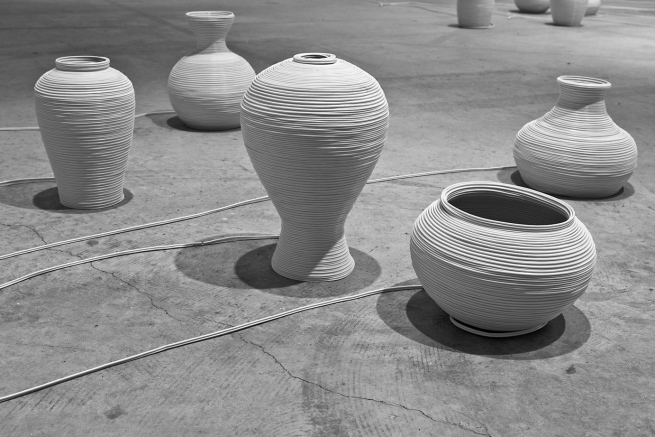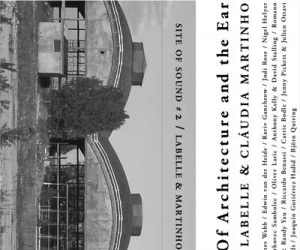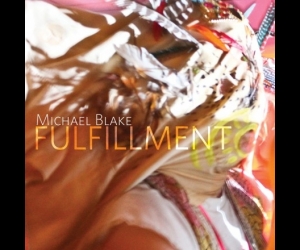
Christof Migone's latest curatorial project since Start, the awashawave exhibition was presented at Blackwood Gallery, hosted by the twenty-second annual Images Festival in Toronto. Migone's curatorial trajectory is amplified by his artistic sensibilities as a sound artist himself, and like Start, Migone brings together seven artists using video, audio, and installation to respond to this state of being. Awashawave rolls off the tongue like a shibboleth, seemingly pushing and pulling, creating and destroying, all at the same time. Many of these works not only evoke some sort of wave imagery or washing analogy, but also pit the analogue and digital against each other, while also allowing the two to work in harmony.
Because Migone's tenacious bonds between themes and works can often suffer in large vacuous spaces, the exhibition is aided by Blackwood's intimate windowless space on the University of Toronto's Mississauga Campus. Presenting the works in such close proximity has a gestalt effect that is approachable, palpable, yet no less layered and meaningful.
Young-Sup Kim's Co-existence_cable porcelain and sound consists of three groups of vessels on the floor, varying in shape and size. Closer inspection reveals these vessels to be made from tightly wound cream-coloured speaker wire. The speakers sitting at the bottom of the vessels emit organic sounds of scratching, rubbing, and tossing, similar to pebbles being rubbed across wet sand. It may not be immediately obvious that these ourobouros-like forms are modelled on traditional Korean washing vessels and emit sounds of rice being cleaned. The sound composition is based on traditional Korean percussion scores. Yet the work's concise and seductive nature entices (but does not force) further study after the first inspection.
Just behind Kim's installation are two large ink-jet prints. Kelly Wood's Nihilist Spasm Band—an Appeal to Reason and John Oswald—Bellspeeds display a series of varying sound waves printed in a grey scale. Dark and light shades of grey render the sound files as dense and obtuse lines, similar to the digital signal processes used by the two musicians. From the Binary Sound Series, the two works render moments from experimental music history: a noise band improvising, and plunderphonics founder Oswald sampling and appropriating sound. Both have their own notoriety. The project is arguably an attempt to visually manifest a sound wave but perhaps also to present a portrait of descent. The work deciphers what “bad” music looks like—“bad” according to the moral majority—and presents itself as a tongue-in-cheek joke.
Equally humorous is Antonina Hirsch's Vox Pop, a duo projection video installation mirroring Wood's prints. The left screen's video silently pans across a seemingly empty stadium, while the screen on the right shows a long shot of a man sitting in a blue seat in row eleven, presumably in the same stadium. When the projection on the left pans across Section Thirty-seven, the man gets out of his chair in a “Wave” gesture, a phenomenon closely linked to large sporting events in jumbotron culture. The man's ambivalent gesture does not create any sort of rupture, nor is it visible in the vast area of blue seats. One can easily read this work as a comment on sports enthusiasts dying off as a result of hockey and baseball strikes. This work's silence is a key to understanding the piece not as a part of fan culture, but as a depiction of how alienating spectatorship can be.
Michael Snow's Short wavelength takes us through a lateral journey passing through inconsequential voices and sounds, where more meaning is achieved through the palpitations between dials. The thirty-five-minute soundwork was played via shortwave radio. The work sounds physical; arguably, it sounds real. Snow's presence doesn't consume the show aurally or conceptually, and the work may seem easily recognizable and readily historically contextualized. Yet the only thing dating the piece is the analogue quality of noise, which is now moving closer and closer to obsolescence. With the immanent end of static in our visual-aural landscape, Short Wavelength is almost an exercise in nostalgia.
True to the show's title, all the works pivot on some manifestation of “a wash” or “a wave,” and they echo each other in a humorous manner. This is certainly true of Kim's speaker-wire porcelain and Wood's manifestation of “noise.” The tense silence of the respective works by Wood and Hirsch is amplified by their placement across from each other in the gallery. Awashawave doesn't need a bucket to carry a tune. Many of the works don't even need sound to ellicit aural sentiments. And that's when Migone's employment of simile works best.
Image: Co-existence_cable porcelain and sound by Young-Sup Kim. Image by: Toni Hafkenscheid, courtesy of Christof Migone and Joanna Sheridan.


